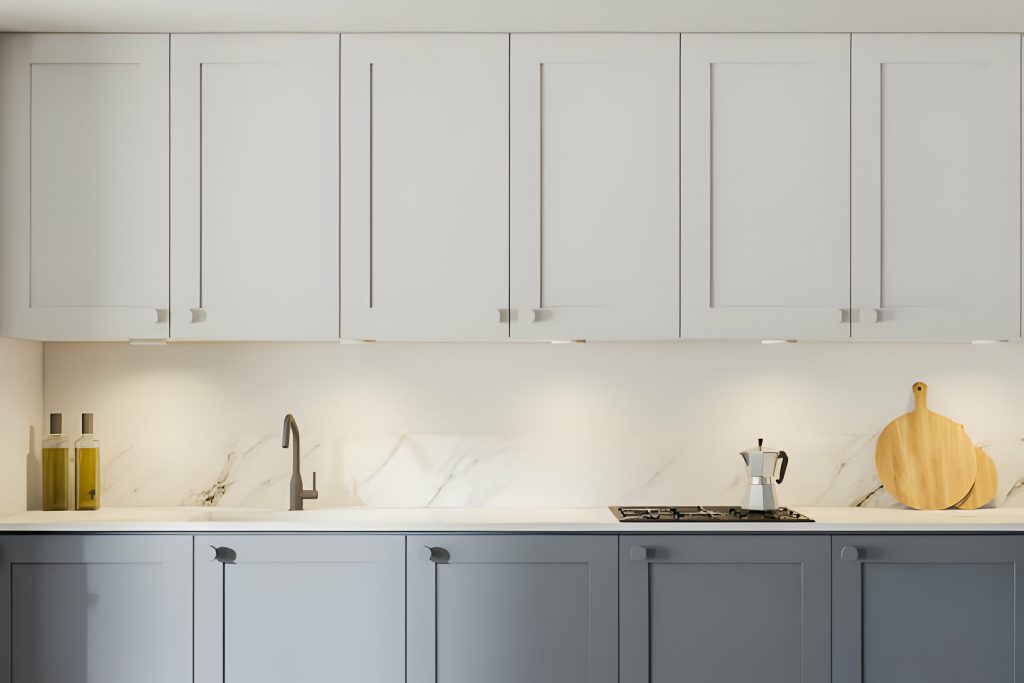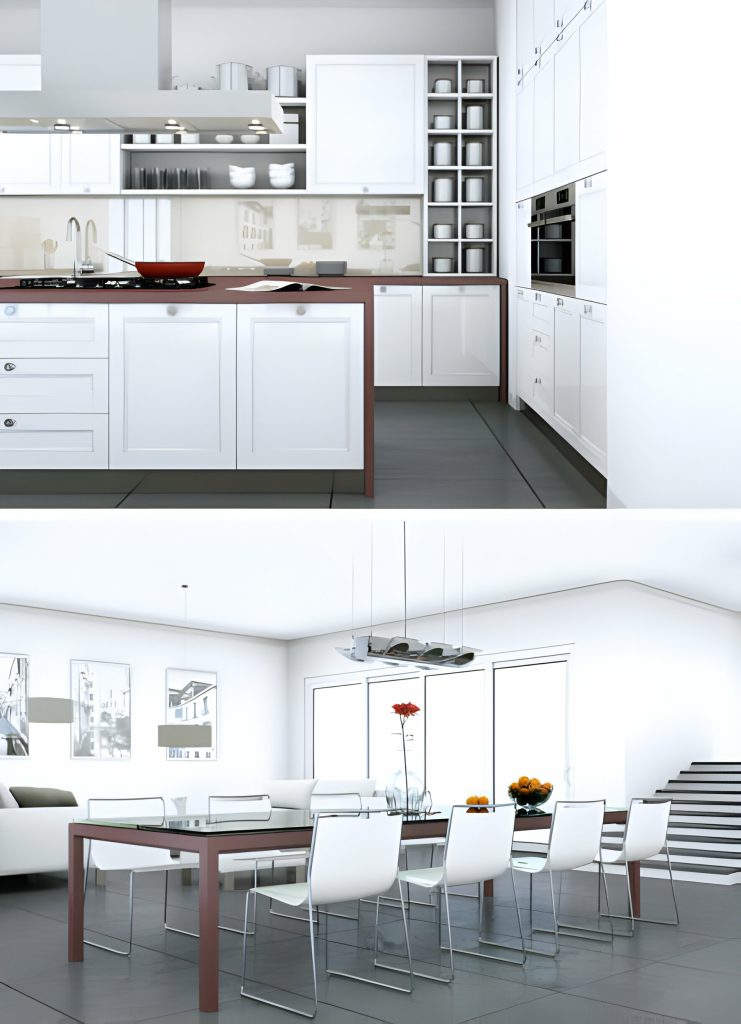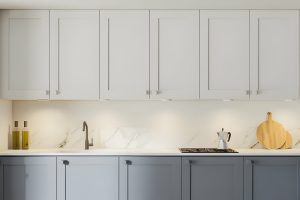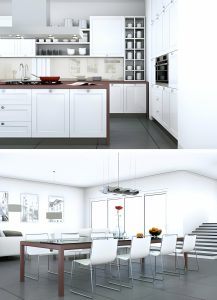Do your kitchen cabinet doors refuse to close properly? Don’t panic – fixing them is easier than you think! In this article, we’ll show you how to get those doors back in tip-top shape. We’ll guide you through identifying the problem, adjusting the hinges, tightening loose screws, lubricating squeaky hinges, aligning the doors, and even installing magnetic catches to keep them secure. Get ready to restore functionality and style to your kitchen cabinets!
Identify the Problem
To properly address the issue, you need to start by looking for any signs of damage or misalignment in your kitchen cabinet doors. Common door issues can include loose hinges, misaligned doors, and worn-out screws. To troubleshoot cabinet doors, begin by inspecting the hinges. Check if they are securely fastened to the cabinet and the door. If any screws are loose, tighten them using a screwdriver. Additionally, check if the hinges are bent or damaged. If so, they may need to be replaced. Next, examine the alignment of the doors. Close the doors and observe if they are level with the surrounding cabinets. If not, adjust the hinges by loosening the screws and repositioning the door until it is aligned. Finally, inspect the screws that hold the hinges in place. If they are worn-out or stripped, replace them with new ones. By identifying these common door issues and troubleshooting cabinet doors accordingly, you can ensure that your kitchen cabinet doors function properly and maintain their aesthetic appeal.
Adjust Hinges
To adjust the hinges on your kitchen cabinet doors, you will need a screwdriver and a keen eye for detail. Adjusting the hinges can solve many common problems with cabinet doors, such as misalignment, sagging, or difficulty in opening and closing. Here are some troubleshooting techniques for common hinge issues:
| Problem | Solution |
|---|---|
| Misaligned doors | Loosen the screws on the hinge and adjust the position of the door until it is aligned with the cabinet frame. |
| Sagging doors | Tighten the screws on the hinge to lift the door and align it with the cabinet frame. |
| Stiff or difficult to open doors | Apply lubricant to the hinge mechanism to reduce friction and improve the door’s movement. |
| Loose hinges | Tighten the screws on the hinge to secure it firmly to the cabinet frame. |
Tighten Loose Screws
You can easily tighten any loose screws on your kitchen cabinet doors. Over time, screws can become loose due to regular use and wear. To fix this issue, you have two options: repairing stripped holes or replacing worn out screws.
To repair stripped holes, you will need a few supplies: a wooden dowel, a drill bit, and wood glue. Start by removing the loose screw and cleaning the area around the hole. Then, dip the wooden dowel in wood glue and insert it into the hole. Cut off any excess dowel using a saw. Next, drill a pilot hole into the dowel using a drill bit that matches the size of the screw. Finally, reinsert the screw into the pilot hole and tighten it until it is secure.
If the screw itself is worn out or damaged, it is best to replace it. Start by removing the old screw using a screwdriver. Then, take the old screw to a hardware store and find a replacement of the same size and type. Insert the new screw into the hole and tighten it until it is secure.
Lubricate Squeaky Hinges
If your kitchen cabinet doors have loose screws, you can also address another common issue by lubricating squeaky hinges. This will help eliminate any annoying squeaks and ensure that your cabinet doors operate smoothly. To quiet hinges and eliminate squeaks, follow these steps:
- Gather the necessary supplies: Before you begin, gather the following items:
- Lubricant spray or oil (such as WD-40 or silicone-based lubricant)
- Clean cloth or rag
- Open the cabinet doors: Open the cabinet doors fully to access the hinges.
- Clean the hinges: Use a clean cloth or rag to wipe away any dirt, dust, or debris from the hinges. This will ensure that the lubricant can penetrate the hinges properly.
- Apply lubricant: Spray a small amount of lubricant onto the hinges. Be sure to apply it directly to the moving parts of the hinge, such as the pivot point and the area where the two metal pieces rub against each other.
- Work the lubricant in: Open and close the cabinet doors several times to work the lubricant into the hinges. This will help distribute the lubricant evenly and ensure a smooth operation.
Align Cabinet Doors
To align cabinet doors, start by adjusting the door hinges. Use a screwdriver to loosen or tighten the screws on the hinges, moving the door up or down until it is level with the other doors. Then, check the alignment of the cabinet doors by placing a level on top of each door and adjusting as necessary.
Adjusting Door Hinges
To properly align your cabinet doors, regularly check and adjust the door hinges using a screwdriver. This is important because misaligned cabinet doors can lead to various common door problems, such as doors that don’t close properly or appear crooked. To address these issues, follow these steps:
- Start by inspecting the hinges for any signs of damage or wear. If necessary, consider replacing hinges that are beyond repair.
- To adjust the door vertically, locate the hinge screws on the cabinet frame and loosen them slightly. Then, lift or lower the door to the desired position and retighten the screws.
- To adjust the door horizontally, locate the screws on the hinge plates attached to the door and loosen them. Move the door left or right to achieve the desired alignment and tighten the screws.
Leveling Cabinet Doors
To level your cabinet doors and ensure proper alignment, use a carpenter’s level to check if they are even. Start by closing the cabinet doors and placing the level vertically along the edge of the door, checking for any gaps or unevenness. If you notice any discrepancies, you can begin the leveling process by installing shims. Shims are thin pieces of material, such as wood or plastic, that can be placed behind the hinges to adjust the door’s position. To install shims, loosen the screws on the hinges and slide the shim into the gap between the hinge and the cabinet frame. Tighten the screws back and recheck the levelness of the door. Repeat this process as needed until the cabinet doors are properly aligned. These leveling techniques will ensure that your cabinet doors are level and visually appealing.
Install Magnetic Catches
Now it’s time to explore the benefits of installing magnetic catches on your kitchen cabinet doors. These catches provide a secure closure, preventing the doors from swinging open and causing damage. The installation process is quick and easy, requiring only a few simple steps. Once installed, magnetic catches enhance the functionality of your cabinets, ensuring that your belongings are safely stored and easily accessible.
Benefits of Magnetic Catches
You can experience several benefits by installing magnetic catches on your kitchen cabinet doors.
- Strong Magnetic Force
- Magnetic catches have a strong magnetic force that keeps your cabinet doors securely closed. This prevents the doors from swinging open unexpectedly and causing damage or injury.
- The strong magnetic force also ensures that the doors stay closed even if they are slightly misaligned, providing a tight and secure seal.
- Durable Construction
- Magnetic catches are built to withstand daily use and are made from durable materials such as metal or high-quality plastic.
- These catches are designed to resist wear and tear, ensuring that they will last for a long time without needing to be replaced.
Easy Installation Process
Installing magnetic catches on your kitchen cabinet doors is a straightforward process that will enhance the functionality and convenience of your cabinets. To ensure a smooth installation, follow these quick fixes and troubleshooting tips:
| Steps | Materials Needed |
|---|---|
| 1. | Measure and mark the position for the magnetic catches. |
| 2. | Use a drill to create pilot holes at the marked positions. |
| 3. | Attach the magnetic catches to the cabinet frame using screws. |
| 4. | Align the corresponding metal plates on the cabinet doors. |
| 5. | Secure the metal plates to the doors using screws or adhesive. |
If the magnetic catches are not properly aligned, doors may not close properly. To troubleshoot this issue, adjust the position of the magnetic catches or metal plates accordingly. Additionally, ensure that the screws are tightened securely to prevent any movement. By following these installation steps and troubleshooting tips, you can quickly fix your kitchen cabinet doors and enjoy the convenience of magnetic catches.
Enhances Cabinet Functionality
To enhance the functionality of your cabinets, install magnetic catches using the following steps and materials:
- Materials needed:
- Magnetic catches
- Screws
- Screwdriver
- Steps to install magnetic catches:
- Determine the desired location for the magnetic catch on the cabinet door.
- Measure and mark the position for the catch on the cabinet frame.
- Attach the magnetic catch to the cabinet frame using screws and a screwdriver.
- Close the cabinet door and align the corresponding metal plate with the magnetic catch.
- Mark the position of the metal plate on the cabinet door.
- Attach the metal plate to the marked position using screws and a screwdriver.
- Test the functionality of the magnetic catch by opening and closing the cabinet door.
Installing magnetic catches enhances cabinet functionality by increasing storage and organizing dishes. The magnetic catches securely hold the cabinet doors in place, preventing them from swinging open and causing potential damage. This feature allows you to maximize your cabinet space by safely storing more items without worrying about the doors opening unexpectedly. Additionally, the magnetic catches create a neat and organized appearance by keeping cabinet doors closed tightly, preventing clutter from being visible. With the magnetic catches installed, you can enjoy a more efficient and convenient kitchen experience.





